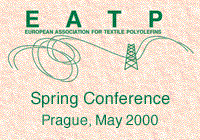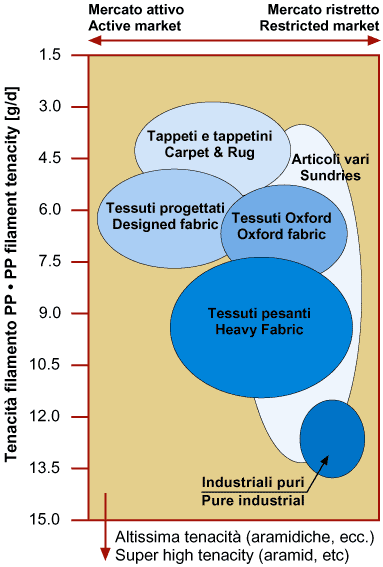 The Polypropylene Fibres Industry in JapanHideo Sakakura
|
|||||||||||||||||||||||||||||||||||||||||||||||||||||||||||||||||||||||||||||||||||||||||||||||||||||||||||||||||||||||||||||||||||||||||||||||||||||||||||||||||||||||||||||||||||||||||||||||||||||||||||||||||||||||
| Year | 1980 | 1985 | 1990 | 1995 | 1996 | 1997 | 1998 | 1999 |
| Filament | 13.9 | 16.9 | 23.3 | 53.9 | 56.0 | 61.0 | 61.0 | 64.4 |
| Staple | 48.3 | 49.1 | 58.5 | 76.7 | 76.7 | 6.77 | 76.7 | 76.7 |
| Total | 62.2 | 66.0 | 81.8 | 130.6 | 132.7 | 137.7 | 137.7 | 141.1 |
3. Production and Demand
In statistics provided by MITI, PP fibres are classified roughly into PP staple and PP filament. And the latter is classified again into PP BCF, multifilament yarn for industrial uses, monofilament yarn and spunbonded.
Note: Estimated on basis of the data of MITI and JCFA
Year
1996
1997
1998
1999
2000 (forecast)
Filament
82.8
88.4
85.6
84.0
86.0
Staple
57.0
60.4
58.0
56.4
57.7
Total
139.8
148.8
143.6
140.4
143.7
(1) In 1999, total production of PP staple decreased by about 3% in comparison with the previous year. Looking at the application field, the carpet recorded a big fall resulting in 4,100 tons, i.e. 11% less compared to the year before, and the industrial material use also decreased to 44.3 thousand tons, i.e. 3% less compared to the year before, but the export increased slightly to 8 thousand tons, i.e. 3% more compared to the year before.
- As to carpet, the demand for the interior use kept to the same level as in 1998. But the demand for automotive fell sharply resulting 1,100 tons, i.e. 27% less compared to the year before, due to the substitution to other materials, e.g. polyester staple. The demand for the carpet by PP staple has decreased year by year, but a new market has been already becoming a reality by recognition as environmental friendly material.
- Regarding the industrial material use, this application has a 79% share of the whole PP staple shipment and had increased from year to year till 1998. But in 1999, the demand for that recorded a slight decrease resulting in 44.3 thousand tons, i.e. 4% less compared to 1998. Dry form nonwovens decreased by 4%. In this application, the thermobondable bicomponent fibres are used for hygienic materials, filters, home goods and so on. In the hygienic products, the diaper application decreased by disadvantage in cost, competition with the spunbonded, and increase of imported nonwovens.
- The export market was occupied mostly by the thermobondable bicomponent fibres, and the volume was 8 thousand tons in 1999, i.e. 3% more compared to the year before. The major factor of this increase is the gradual recovery of the Asian markets.
Source: the Polypropylene Committee of JCFA
Year
1997
1998
1999
2000 (forecast)
Carpets
5.1
4.5
4.1
3.8
for Interior
3.6
3.0
3 0
for Automotive
1.5
1.5
1 1
Industrial material use
44.8
45.9
44.3
46.4
Nonwovens (dry)
35.8
37.4
35.7
Nonwovens (wet)
2.4
2.4
2.5
Others
6.6
6.1
6.1
Exports
10.5
7.6
8.0
7.5
Total
60.4
58.0
56.4
57.7
(2) In 1999, total production of PP filament equaled an estimated 84 thousand tons, i.e. 2% less compared to the year before. Looking at the application field, the spunbonded kept to the same level as in 1998 and having a 45% share in total shipment of PP filament, and the multifilament yarn for industrial uses did not change in quantity either compared to 1998. On the other hand, PP BCF increased by 10% compared to the year before.
It has increased a share in the markets of tile carpet and automotive application gradually by taking over Nylon BCF of its share. Nylon BCF lacks the cost competitiveness with the market price, and PP BCF has the advantage of the environment-friendly and low-pollutive material in the demand for recycling.
Source: Estimated on basis of the data of MITI and JCFA
Year
1997
1998
1999
2000 (forecast)
PP-BCF
5.5
6.0
6.6
7.0
Multifilament yarn
4.7
4.0
4.0
4.6
Spunbonded
35.2
37.8
38.0
39.5
Flat yarn
31.5
27.6
25.4
25.0
Monofilament yarn
11.5
10.1
10.0
9.9
Total
88.4
85.6
84.0
86.0
4. The Forecast for 2000
The new year started without serious errors in computers, Y2K problem, worried in the world. Owing to the governmental action to revive the economy, the business recovery in Southeast Asia and Europe, and the continuous prosperity in the USA, the Japanese economy will recover gently, and its economic growth rate in 2000 is expected to be more than 1%. Under these circumstances, total demand for PP staple fibres in Japan will increase slightly compared to last year.
- As to the carpet, the construction material use is expected to increase through gentle business recovery, but the automotive interior use will fall sharply by replacement to other materials.
- As to the industrial material field, the dry form nonwovens are expected to increase sharply at more than 10%. Above all, we expect the expansion of hygienic market mainly of the use for adult incontinence.
- The situation of PP staple is very severe, because of the sudden rise in prices of raw materials, the competition with cheap imported products, and the more building of plants for spunbonded. The continuous effort for cost reduction and the development of functional value-added materials are expected.
And total demand for PP filament in Japan will also increase compared to last year.
- The demand for PP spunbonded is expected to grow at 3 or 4% compared to last year. That for PP BCF is expected to increase at 5%.
- In the demand for PP multifilament, we expect a sharp expansion at more than 10% by the effective public investment.
- The demand for flat yarn and monofilament will decrease slightly compared to last year.
To conclude, the total demand for the Japanese PP fibres in 2000 will most likely show an increase of a few percent compared to last year and will come back to its level in 1998.
5. Trend of Fibre Consumption for Industrial Materials in Japan
The fibre consumption for the application to industrial materials was 686 thousand tons, having a 45% share of its total in 1998.
Source: JCFA (Japan Chemical Fibre Association)
Year
1994
1997
1998
Apparel
509
437
419
Home Goods
305
257
230
Interior
202
201
184
Industrial materials
693
728
686
Total
1,709
1,623
1,519
The outlook for the demand for industrial materials is shown in Table 6 . Looking at the end uses, the bedding-wadding is the largest; about a 30% share and the use for automotive is the second largest; 22%. But a large increase isn't expected in these applications. On the other hand, the steady growth is expected in geotextile and hygienic materials.
The details of industrial materials are shown in Table 7. The consumption on synthetic fibres is 374,000 tons, having a 54.5% share. Polyester is the largest, 169,200 tons (24.7%) and Polypropylene, 70,200 tons (10.5%), and Nylon, 6,500 tons (9.5%), are following.
The end uses as industrial materials are classified into Tire Cord, Rope-Net, Heavy Fabric, Packing-Sewing, Felt Fabric, Nonwovens Fabric, Automotive and Others.
Polyester fibre and Nylon one are used for many applications, but the end uses of Polypropylene fibre are restricted considerably. They are, for example Nonwovens, Rope-Net, Packing, Tape, Braid, Tatami mat and so on. The suitable properties are demanded to each applications. The relation between fibre tenacity and the end uses is shown in Fig-1.

Fig. 1 Relation between fibre tenacity and the end uses
The end uses which need high tenacity yarn may make the restricted markets, because high tenacity is demanded for special parts in this applications, furthermore some other properties, e.g. dyeability, fashionability, and so on, are lost by increase of tenacity.
Source: JCFA (Japan Chemical Fibre Association)
Year
1995
2000
2005
Bedding-Wadding
242 (35%)
240 (32%)
245 (30%)
Automotive
168 (24%)
174 (23%)
175 (22%)
Geotextile
62 (9%)
85 (11%)
105 (13%)
Medical-Hygienic
50 (7%)
72 (10%)
96 (12%)
Environmental
19 (3%)
23 (3%)
29 (4%)
Agriculture-Fisheries
26 (4%)
28 (4%)
28 (4%)
Others
120 (17%)
121 (16%)
125 (16%)
Total
686
742
802
Table 7. The fibres consumption of industrial material application in1998
6. MRC's Operations in industrial market
The domestic demand and the production for polypropylene multifilament are decreasing in Japan, because the manufactures of typical applications, such as ropes, nets, tapes, braid, packing, and so on, moved to overseas. Mitsubishi Rayon is the top producer of PP multifilament in Japan. The development of new markets for it is very important for us. We started the development of the fields of designed fabrics using PP multifilament, for example, office furnishing (chair clothes, partition), heavy fabric for tents, automotive interior, and so on. The characteristics of polypropyelene, i.e. good removability to stains, lightness, light resistance and aptitude for recycling, will create the advantage in these applications, we hope.
This article is published on NF New Fibres, see the contents.